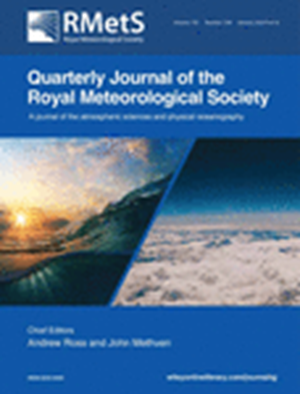使用观测减背景和观测减分析统计估计观测误差协方差矩阵时的抽样误差和误判误差
IF 2.9
3区 地球科学
Q2 METEOROLOGY & ATMOSPHERIC SCIENCES
引用次数: 0
摘要
数据同化系统观测误差协方差矩阵的指定会影响分析所保留的观测信息内容,特别是对于已知观测误差相关的观测(如地球静止卫星和多普勒雷达数据)。估计观测误差协方差矩阵的一种广泛采用的方法是使用观测减背景和观测减分析残差,大多数数据同化系统都会产生这些残差。虽然众所周知,这种方法会因采样和误设误差而产生有偏差和有噪声的估计值,但迄今为止还没有系统地研究过这种方法的采样误差。此外,众所周知,估计观测误差协方差矩阵的特征谱会影响变分同化方案的分析信息含量和数值收敛性。在这项工作中,我们用这种方法为估计观测-误差协方差矩阵的采样误差和特征值提供了新的定理。我们还进行了数值实验来说明我们的理论结果。我们发现,如果真实观测-误差标准差较大,这种方法会产生较大的抽样误差,而其他误差特征,包括真实背景-误差标准差以及观测-误差和背景-误差相关长度尺度,则影响相对较小。我们还发现,估计矩阵的最小特征值可能比真实特征值小,也可能比真实特征值大,这取决于假定的和真实的观测和背景误差统计量。这些结果可为实际应用提供启示:例如,在决定适当的样本大小和为矩阵重整技术选择参数时。本文章由计算机程序翻译,如有差异,请以英文原文为准。
Sampling and misspecification errors in the estimation of observation‐error covariance matrices using observation‐minus‐background and observation‐minus‐analysis statistics
Specification of the observation‐error covariance matrix for data assimilation systems affects the observation information content retained by the analysis, particularly for observations known to have correlated observation errors (e.g., geostationary satellite and Doppler radar data). A widely adopted approach for estimating observation‐error covariance matrices uses observation‐minus‐background and observation‐minus‐analysis residuals, which are routinely produced by most data assimilation systems. Although this approach is known to produce biased and noisy estimates, due to sampling and misspecification errors, there has been no systematic study of sampling errors with this approach to date. Furthermore, the eigenspectrum of the estimated observation‐error covariance matrix is known to influence the analysis information content and numerical convergence of variational assimilation schemes. In this work, we provide new theorems for the sampling error and eigenvalues of the estimated observation‐error covariance matrices with this approach. We also conduct numerical experiments to illustrate our theoretical results. We find that this method produces large sampling errors if the true observation‐error standard deviation is large, while the other error characteristics, including the true background‐error standard deviation and observation‐ and background‐error correlation length‐scales, have a relatively small effect. We also find that the smallest eigenvalues of the estimated matrices may be smaller or larger than the true eigenvalues, depending on the assumed and true observation‐ and background‐error statistics. These results may provide insights for practical applications: for example, in deciding on appropriate sample sizes and choosing parameters for matrix reconditioning techniques.
求助全文
通过发布文献求助,成功后即可免费获取论文全文。
去求助
来源期刊
CiteScore
16.80
自引率
4.50%
发文量
163
审稿时长
3-8 weeks
期刊介绍:
The Quarterly Journal of the Royal Meteorological Society is a journal published by the Royal Meteorological Society. It aims to communicate and document new research in the atmospheric sciences and related fields. The journal is considered one of the leading publications in meteorology worldwide. It accepts articles, comprehensive review articles, and comments on published papers. It is published eight times a year, with additional special issues.
The Quarterly Journal has a wide readership of scientists in the atmospheric and related fields. It is indexed and abstracted in various databases, including Advanced Polymers Abstracts, Agricultural Engineering Abstracts, CAB Abstracts, CABDirect, COMPENDEX, CSA Civil Engineering Abstracts, Earthquake Engineering Abstracts, Engineered Materials Abstracts, Science Citation Index, SCOPUS, Web of Science, and more.

 求助内容:
求助内容: 应助结果提醒方式:
应助结果提醒方式:


